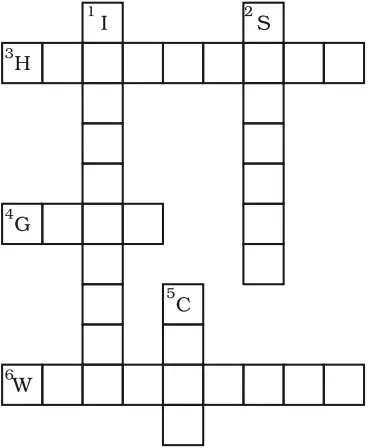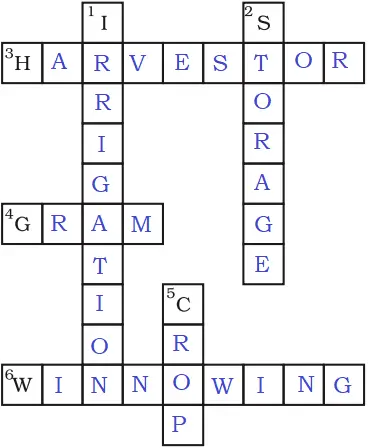NCERT Solution for Class 8 Science - Chapter 1 Crop Production and Management
Are you looking for NCERT Solution of Class 8 Science – Chapter 1 Crop Production and Management? You are at the right place. All the Extra Questions, Revision Notes, MCQs are available here. All the study materials are completely FREE.
Exercises
Question.1. Select the correct word from the following list and fill in the blanks.
float, water, crop, nutrients, preparation
(a) The same kind of plants grown and cultivated on a large scale at a place is called _____________.
Answer. The same kind of plants grown and cultivated on a large scale at a place is called crop.
(b) The first step before growing crops is _____________ of the soil.
Answer. The first step before growing crops is preparation of the soil.
(c) Damaged seeds would _____________ on top of water.
Answer. Damaged seeds would float on top of water.
(d) For growing a crop, sufficient sunlight and _____________ and _____________ from the soil are essential.
Answer. For growing a crop, sufficient sunlight and water and nutrients from the soil are essential.
Question.2. Match items in column A with those in column B.
| A | B |
|---|---|
| (i) Kharif crops | (a) Food for cattle |
| (ii) Rabi crops | (b) Urea and super phosphate |
| (iii) Chemical fertilisers | (c) Animal excreta, cow dung urine and plant waste |
| (iv) Organic manure | (d) Wheat, gram, pea |
| (e) Paddy and maize |
Answer.
| A | B |
|---|---|
| (i) Kharif crops | (e) Paddy and maize |
| (ii) Rabi crops | (d) Wheat, gram, pea |
| (iii) Chemical fertilisers | (b) Urea and super phosphate |
| (iv) Organic manure | (c) Animal excreta, cow dung urine and plant waste |
Question.3. Give two examples of each.
(a) Kharif crop
Answer. Paddy, maize, soyabean, groundnut, cotton, etc.
(b) Rabi crop
Answer. Wheat, gram, pea, mustard, etc.
Question.4. Write a paragraph in your own words on each of the following.
(a) Preparation of soil
Answer. The preparation of soil is the first step before growing a crop. One of the most important tasks in agriculture is to turn the soil and loosen it. This allows the roots to penetrate deep into the soil. The loosened soil helps in the growth of earthworms and microbes which are friends of the farmer and add humus to it. Also, turning and loosening of soil brings the nutrient-rich soil to the top so that plants can use these nutrients.
(b) Sowing
Answer. Sowing is the most important part of crop production. Before sowing, good quality seeds are selected. Good quality seeds are clean and healthy seeds of a good variety. Seeds can be sown by seed drill or manually.
(c) Weeding
Answer. Weeds are unwanted plants that grown along with crops and removal of weeds is known as weeding. Weeds can be removed either manually by using tools like khurpi or by using weedicides like 2, 4 – D. These are sprayed in the fields to kill the weeds.
(d) Threshing
Answer. The process of separation of the grains from the chaff is called threshing. This is carried out with the help of a machine called ‘combine’ which is in fact a combined harvester and thresher.
Question.5. Explain how fertilisers are different from manure.
Answer. The main Differences between Fertiliser and Manure are as follows:
| Fetilisers | Manures |
|---|---|
| 1. A fertiliser is an inorganic salt. | 1. Manure is a natural substance obtained by the decomposition of cattle dung, human waste and plant residues. |
| 2. A fertiliser is prepared in factories. | 2. Manure can be prepared in the fields. |
| 3. A fertiliser does not provide any humus to the soil. | 3. Manure provides a lot of humus to the soil. |
| 4. Fertilisers are very rich in plant nutrients like nitrogen, phosphorus and potassium. | 4. Manure is relatively less rich in plant nutrients. |
Question.6. What is irrigation? Describe two methods of irrigation which conserve water.
Answer. The supply of water to crops at different intervals is called irrigation. The two methods of irrigation which conserve water are as follows:
- Sprinkler System: Under this method, the perpendicular pipes, having rotating nozzles on top, are joined to the main pipeline at regular intervals. When water is allowed to flow through the main pipe under pressure with the help of a pump, it escapes from the rotating nozzles. It gets sprinkled on the crop as if it is raining.
- Drip system: In this system, the water falls drop by drop just at the position of the roots. It is the best technique for watering fruit plants, gardens and trees. Water is not wasted at all. It is a boon in regions where availability of water is poor.
Question.7. If wheat is sown in the kharif season, what would happen? Discuss.
Answer. Wheat is a rabi crop, hence it requires cold climatic conditions to be grown properly. If it is sown in the kharif season, it will not grow or may get destroyed due to excessive rains in the kharif season.
Question.8. Explain how soil gets affected by the continuous plantation of crops in a field.
Answer. Soil supplies mineral nutrients to the crop. These nutrients are essential for the growth of plants. Continuous growing of crops in the same field makes the soil poorer in certain nutrients. This makes the soil infertile. And then, to replenish the soil with nutrients farmers need to add manures to the soil.
Question.9. What are weeds? How can we control them?
Answer. The undesirable plants may grow naturally along with the crop are called weeds. There are many ways to remove weeds and control their growth. Weeds can be removed by uprooting or cutting them close to the ground, from time to time. This is done with the help of a khurpi.
Weeds are also controlled by using certain chemicals, called weedicides, like 2, 4–D. These are sprayed in the fields to kill the weeds.
Question.10. Arrange the following boxes in proper order to make a flow chart of sugarcane crop production.
Question.11. Complete the following word puzzle with the help of clues given below.
Down
1. Providing water to the crops.
2. Keeping crop grains for a long time under proper conditions.
5. Certain plants of the same kind grown on a large scale.
Across
3. A machine used for cutting the matured crop.
4. A rabi crop that is also one of the pulses.
6. A process of separating the grain from chaff.

Down
1. Irrigation
2. Storage
5. Crop
Across
3. Harvester
4. Gram
6. Winnowing




